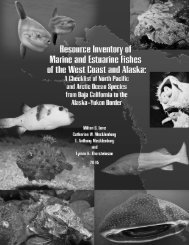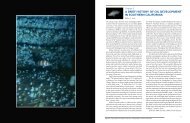Reproductive Ecology and Body Burden of Resident ... - The Love Lab
Reproductive Ecology and Body Burden of Resident ... - The Love Lab
Reproductive Ecology and Body Burden of Resident ... - The Love Lab
Create successful ePaper yourself
Turn your PDF publications into a flip-book with our unique Google optimized e-Paper software.
<strong>of</strong> non-drilling associated discharges from <strong>of</strong>fshore oil platforms, but along with sanitary/domestic waste,<br />
this discharge is only a source <strong>of</strong> residual chlorine (Steinberger et al. 2005). Produced waters are natural<br />
geological formation water <strong>and</strong> includes introduced seawater recovered with the extraction <strong>of</strong> oil (Raco<br />
1994). <strong>The</strong> produced water is separated from the oil <strong>and</strong> gas mixture on site at an <strong>of</strong>fshore platform or is<br />
sent via pipeline to an onshore facility. After separation, the produced water is treated <strong>and</strong> discharged to the<br />
ocean. If processed onshore, the produced water is transferred by pipeline back to the source platform <strong>and</strong><br />
discharged. <strong>The</strong> release <strong>of</strong> produced water is intermittent over hours or days <strong>and</strong> discharge rate <strong>and</strong> volume<br />
varies over time <strong>and</strong> among platforms (D. Panzer, U.S. Minerals Management Service, pers. comm.).<br />
Over the life <strong>of</strong> the well as the amount <strong>of</strong> oil in the well decreases, the quantity <strong>of</strong> produced water<br />
extracted with oil <strong>and</strong> gas increases as the process <strong>of</strong> water-flooding with seawater is used to enhance hydrocarbon<br />
production from an aging well. Consequently, the concentrations <strong>of</strong> constituent elements, such as<br />
Ba, in the discharge <strong>of</strong>ten decreases over time. Eleven platforms were discharging produced water in 1990;<br />
14 platforms in 1996, <strong>and</strong>14 platforms in 2000. Steinberger et al (2005) reported that discharges <strong>of</strong> produced<br />
water were 2.3% higher in 1996 than in 1990, <strong>and</strong> 7.3% higher in 2000 than in 1990. All <strong>of</strong> the platforms in<br />
federal waters included in our study (the exception is Platform Holly in State waters) presently discharge<br />
produced water.<br />
Ba is the largest metal constituent in mass emissions from produced water discharged from platforms<br />
(Steinberger et al. 2005). Higashi et al (1997) reported that Ba <strong>and</strong> Sr were the only elements among Al,<br />
As, Cd, Co, Cu, Cr, Fe, Mn, Mo, Pb, Sn, Zn that were consistently in high concentration in produced water<br />
from an oil processing facility in Carpinteria. Only one element, Cu, among Mg, Sr, Mn, Fe, <strong>and</strong> Ba included<br />
in our otolith chemistry statistical analysis, is monitored <strong>and</strong> reported in Discharge Monitoring Reports<br />
(DMRs) submitted by individual platforms in compliance with NPDES permit requirements. Metals included<br />
in the DMRs are Cd, Cr, Cu, Pb, Hg, Ni (Nickel), Se (Selenium), Ag, <strong>and</strong> Zn. Steinberger et al. (2005)<br />
estimated 1734 kg <strong>of</strong> Ba was released from federal Southern California platforms in 1996; in comparison,<br />
0.19 kg <strong>of</strong> Cu was released in the same year. Estimated flow-weighted concentrations were 323 µg l -1 (2.352<br />
µM) for Ba <strong>and</strong> 0.04 µg l -1 (6.295x10 -4 µM) for Cu in produced water discharges in 1996 (Steinberger et al.<br />
2005). <strong>The</strong> general platform permit limit for Cu discharge is 20 µg l -1 (0.315 µM).<br />
Ba enrichment in otoliths <strong>of</strong> kelp rockfish from platforms may have been related to the discharge <strong>of</strong><br />
produced water. Kelp rockfish inhabiting the midwater structure <strong>of</strong> the platform may be exposed to elevated<br />
Ba Ca -1 which we were unable to detect from our water samples. Higashi et al (1997) reported that M. californianus<br />
showed a clear decreasing trend in Ba accumulation levels in newly grown shell material with increasing<br />
distance from a produced water outfall <strong>of</strong>f Carpinteria in some but not all outplanting experiments<br />
conducted over the course <strong>of</strong> a year suggesting that seasonal currents patterns may have affected dispersal<br />
<strong>of</strong> the discharge.<br />
As in our study, Warner et al. (2005) found no relationship between Ba from the outermost material <strong>of</strong><br />
adult kelp rockfish otoliths <strong>and</strong> Ba Ca -1 from seawater collected at the time fish were sampled in 2002 from<br />
rocky reef sites <strong>of</strong>f west Santa Barbara, northeast Santa Cruz Isl<strong>and</strong>, <strong>and</strong> south Santa Cruz Isl<strong>and</strong>. <strong>Lab</strong>oratory<br />
<strong>and</strong> field studies have determined that otolith Ba correlates with ambient Ba in seawater (Bath et al. 2000,<br />
Elsdon <strong>and</strong> Gill<strong>and</strong>ers 2003, Elsdon <strong>and</strong> Gill<strong>and</strong>ers 2005). <strong>The</strong> field studies compared estuarine <strong>and</strong> coastal<br />
habitats where differences in otolith Ba are more extreme than open coastal site comparisons (e.g., Brown<br />
2006).<br />
If found to be temporally consistent, unique signatures <strong>of</strong> elements incorporated in the structure <strong>of</strong><br />
otoliths <strong>of</strong> kelp rockfish potentially can be used as a tool to reconstruct an individual’s history <strong>of</strong> movement<br />
among habitats. However, we suspect that otolith Ba is temporally variable. For example, Warner et<br />
al. (2005) reported the mean Ba Ca -1 in seawater was 3.97 (S.E.=0.05, n=12) µmol/mol from the vicinity <strong>of</strong><br />
our kelp rockfish natural site in the west Santa Barbara area <strong>and</strong> 3.75 (SE=0.107, n=6) µmol/mol from a<br />
61




